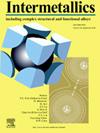In-situ formation of γ-TiAl based alloy coatings on a titanium alloy by tungsten inert gas cladding
IF 4.3
2区 材料科学
Q2 CHEMISTRY, PHYSICAL
引用次数: 0
Abstract
The γ-TiAl based alloy coatings were synthesized on the Ti-5Al alloy substrates through in-situ surface alloying using the tungsten inert gas (TIG) cladding method. The effects of welding parameters on the microstructure, phase composition and microhardness of the coatings were investigated. The temperature gradient and cooling rate distributions during the melting-solidification process were calculated by means of a numerical simulation method. The results demonstrated that a higher welding current resulted in a narrower and deeper welding pool, while an appropriate increase in welding speed led to a shallower and wider one. A continuous cladding layer without microdefects was obtained at the welding current of 80 A and the welding speed of 200 mm/min. The layer contained about 47.62 at.% Al and was composed of γ-TiAl and α2-Ti3Al phases. The crystallizing morphologies in the welding pool transitioned from planar grains at the bottom to dendrites growing from the bottom to the center, and finally to dendrites aligned with the welding direction at the top. The phase transition of the dendrites proceeded as L→α→γ+α2, and the interdendritic constituents evolved along L→α→γ, ultimately forming a microstructure of massive γ distributed between the α2/γ lamellar colonies. The microhardness of the cladding layer was above 350 HV0.1. The as-synthesized coating had the potential to improve surface properties of the titanium alloy.

求助全文
约1分钟内获得全文
求助全文
来源期刊

Intermetallics
工程技术-材料科学:综合
CiteScore
7.80
自引率
9.10%
发文量
291
审稿时长
37 days
期刊介绍:
This journal is a platform for publishing innovative research and overviews for advancing our understanding of the structure, property, and functionality of complex metallic alloys, including intermetallics, metallic glasses, and high entropy alloys.
The journal reports the science and engineering of metallic materials in the following aspects:
Theories and experiments which address the relationship between property and structure in all length scales.
Physical modeling and numerical simulations which provide a comprehensive understanding of experimental observations.
Stimulated methodologies to characterize the structure and chemistry of materials that correlate the properties.
Technological applications resulting from the understanding of property-structure relationship in materials.
Novel and cutting-edge results warranting rapid communication.
The journal also publishes special issues on selected topics and overviews by invitation only.
 求助内容:
求助内容: 应助结果提醒方式:
应助结果提醒方式:


